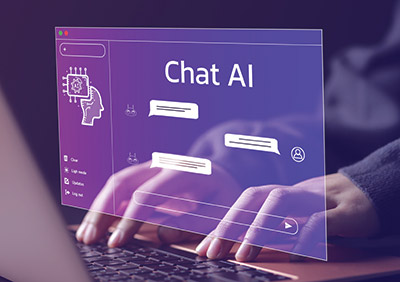Artificial intelligence—also known as AI—is rapidly reshaping how many industries operate, powering everything from self-driving cars and voice assistants to real-time translation and digital art creation.
By Michael Clark
(Originally printed in the July/August 2025 issue of Insights.)

In the personalization industry, AI has quickly become a practical tool—helping shop owners streamline parts of their businesses to save time, refine designs, and improve customer communications.
With several AI platforms now on the market, including major players like Claude and ChatGPT for text-based prompts and Midjourney and Gemini for artwork, it is an opportune time for retailers to familiarize themselves with how to use these tools to enhance their businesses
Maintaining a Creative Touch
One significant benefit of AI for retailers is the ability to speed up design tasks. Several popular platforms such as Adobe and Canva now have built-in AI tools that creators can use to generate initial design ideas. Simply enter a command prompt or upload an existing image and ask the AI for modifications.
AI platforms can create faster mock-ups and layout ideas and even automate proofing processes by building a set of premade responses that businesses can use for design approval.
Dan Bencsik of Bux-Mont Awards & Engraving in southeast Pennsylvania says he uses AI to simplify everyday tasks like customer follow-ups and proofing, resulting in a “more efficient and well-defined workflow.”
 Bencsik notes that the key to making AI a purposeful tool is using it as support instead of as a replacement for designers. The final product should still be reviewed and refined by human eyes. This balance ensures a retailer’s designs stay original, personal, and aligned with branding.
Bencsik notes that the key to making AI a purposeful tool is using it as support instead of as a replacement for designers. The final product should still be reviewed and refined by human eyes. This balance ensures a retailer’s designs stay original, personal, and aligned with branding.
“We ensure customers understand that all final products are reviewed, edited, and approved by a designer,” says Bencsik.
Michael Mullins of Sonoma Laser Engraving shares a similar approach.
“I only use AI for my own works, promotional material, and some ready-to-buy patterns that I sell on Etsy,” says Mullins. “The final works are modified and edited by me before being used or sold.”
Smarter Communication, Less Effort
AI models—especially the language-based ones—are trained to understand, generate, and work with human communication. This makes them great tools for improving communications with customers. A good strategy to implement AI for this is to build a set of prompts that can be used repeatedly with minor adjustments for campaigns, email messages, and social media posts. Some examples of AI-driven communications might include:
Personalized customer emails: These can be templated, with spots to drop in a customer’s name, company name, and specific details about their design and due dates.
Example prompt for AI: Create a customizable email template my business can use to reach out to customers. Please make it have a conversational tone and spots where I can fill in due dates. We also want it to mention attached artwork mock-ups and make sure it includes all our contact info from our website [link here].
Social media posts: Retailers who maintain a steady social media presence can pair their resources with AI to help generate a schedule of weekly posts, be it sales promos or more conversational posts to improve engagement. For those interested in long-term social calendars, several AI platforms are capable of building out a schedule based on a user’s suggestions.
Example prompt for AI: Build a 12-month social media calendar for my engraving business, factoring in branding from our website [link here] and seasonality. Use our Instagram account and Facebook page as sources for inspiration: [social links here].
Marketing and sales campaigns: Retailers can create campaign templates and tweak them based on things like seasonality, sales goals, and customer types. These campaigns could focus around holidays, back-to-school, championship seasons, or any other seasonal scenarios where retailers want to gain customers.
Example prompt for AI: Create a marketing brief we can use to run a sales campaign focused on our local school, [school name], and their upcoming football season. Build two to three examples of sales promos to show them how we can create customized awards and plaques for them at a reasonable cost.
Regardless of what retailers use AI for, the ultimate goal is to help stay organized and ensure every customer interaction is intentional and effective, says Bencsik.
“We use AI to create a more cohesive, efficient workflow across departments,” he adds. “It’s a valuable tool for optimizing how we move jobs through the shop—from order intake to production and customer follow-up.”
When it comes to writing, Mullins suggests training AI tools to match your personal voice for heightened authenticity. This is increasingly important as customers become wary of generic, overly polished messaging.
Getting Started: Start Small, Think Big
 Instead of overhauling your entire business plan using AI, most recommend the best approach is to start small when implementing this technology.
Instead of overhauling your entire business plan using AI, most recommend the best approach is to start small when implementing this technology.
Retailers can start by testing one to two prompts with an AI tool, like asking for email templates or social media posts, and refining their approach.
As you gain confidence with the technology, you can eventually use it for more advanced areas like inventory, production planning, or targeted marketing strategies.
While AI can’t be implemented for personalizing all products, Bencsick says Bux-Mont has had luck using it to create mock-ups and preview designs for customers for hard goods such as plaques, tumblers, and signs. Creating mock-ups and previews showing customers what the product will look like in the finished stage improves the proofing process.
“It’s less about automating the design and more about using AI to communicate, set expectations, and reduce revision cycles,” he says.
Using AI to create product mock-ups can also help reduce a retailer’s overhead, since it removes the need for a physical sample and simplifies the updating process if customers ask for a change.
While AI platforms are powerful tools, they are still prone to making mistakes, often referred to as hallucinations. These can be inaccurate or even nonsensical responses, so having a human check the output at every step helps ensure that what you’re working with is a viable product.
Legal and Ethical Guidelines
While AI can be a helpful tool for businesses, it raises important legal and ethical considerations. One area of discussion is with AI-generated imagery. Some argue the value of this type of artwork since it doesn’t require design skills to churn out an initial image. And since AI-generated imagery is built off of what it has learned from endless images across the internet, there’s also a concern about plagiarizing original work.
Bencsik says that while his business hasn’t faced pushback from customers, they’ve taken proactive steps to be transparent about how AI is used.

“We explain that AI is a tool like Photoshop or CAD software,” he says. His team ensures that their customers understand that, even if AI has been used during the brainstorming phase, any final product has been built by humans.
He points out that a simple AI-usage disclosure in customer proposals can improve trust and answer any questions or concerns early in the proofing process.
For privacy purposes, Bencsik also recommends avoiding entering client logos, names, or other proprietary info into public AI systems. Even if you’re using a paid account, it’s generally not advised to store any sensitive information on an AI platform since the technology is still relatively new and security isn’t always discernible.
Businesses using AI should also work with legal counsel to update their service agreements. Adding clauses about intellectual property, prompt documentation, and the responsible use of generative tools can help clarify policies.
Michael Stewart and Kristyn Webb from Fishman Stewart PLLC urge business owners to keep their terms and conditions up-to-date—especially for jobs involving AI-generated content. To help with this, their firm offers a customizable Artisan Agreement that clarifies ownership, liability, and usage rights when fulfilling customer-provided orders.
They outline three main things retailers should specify: clear terms on who owns which rights to the art, clear language that requires the client to state that they aren’t ordering something that would infringe on anyone else’s intellectual property rights, and clear language that states the client will pay the retailer if there is an infringement claim.
To see the free agreement, visit: https://fishstewip.com
Webb and Stewart recommend that retailers register any original creative content they produce with the U.S. Copyright Office.
“In most cases, you must have a registration before you can sue to enforce your rights. Mailing something to yourself or getting a notarized copy of the art is not a substitute for registration,” say Webb and Stewart.
Internally, retailers should focus on creating AI ethics and copyright awareness in employee training and standard operating procedures.
“Businesses should have clear policies on appropriate uses of AI platforms and train employees on this too,” say Webb and Stewart.
The firm also offers a step-by-step guide on how to keep trade secrets secure that may be useful for retailers.
To see the guide, visit: https://fishstewip.com
Staying Up to Speed
AI technology is new and constantly changing. To stay current on the changes, consider attending trade shows where education sessions provide new findings on what’s working (and what’s not) with AI.
Networking with industry colleagues can help retailers get a sense of what kind of prompts they should use to meet customer expectations.
Another way to stay in the know is to check articles and press releases on the topic from trusted industry sources. Bencsick recommends organizations like Creative Commons and the Electronic Frontier Foundation for the latest and most accurate information on the topic.
Lastly, you can ask most AI platforms to give you a recap of any recent updates to the system so you’re always utilizing the latest features. Updates typically happen automatically, but sending a prompt every week or two will give you a current rundown. For example, with ChatGPT, simply asking, “What are the latest ChatGPT updates?” yields detailed results on all recent changes on the platform, from user-friendly features to more in-depth technical tools for pro users.
Getting Ahead of the Curve
The next few years will yield increasingly powerful AI tools that retailers can use to improve their business operations. However, getting familiar with the technology now will help you get up to speed and position yourself to use the tools as they evolve.
At the recent International Personalization Expo in Las Vegas, during the presentation “Making the Most of Artificial Intelligence,” panel members framed it as such: “AI isn’t going to take your job away; it’s people who know how to use AI who are going to take your job away.”
Embracing AI today isn’t just smart—it’s how you stay relevant, competitive, and ready for whatever comes next.
Michael Clark is the content marketing manager for Inktavo, a
family of software solutions that help print shops, promotional
product distributors, and branded merchandise businesses
succeed. Over the past decade, he’s also contributed as an editor
and columnist to several publications in the decorated apparel,
promotional products, and signage industries.
